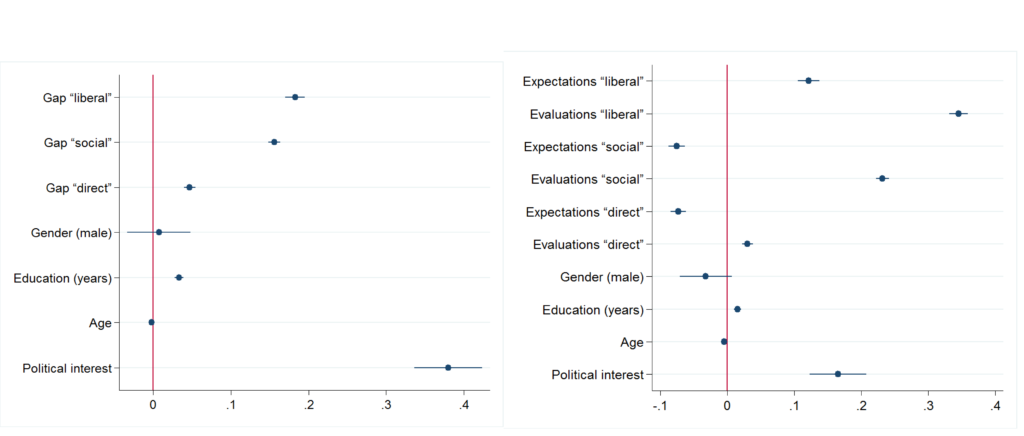Dissatisfaction with democracy in Europe is primarily a function of how well citizens perceive their political system to perform, and not of rising expectations
Is democratic dissatisfaction caused by critical citizens’ high expectations? In new research,Lea Heyne finds that dissatisfaction is not, in fact, caused by voters having increased demands of what a democratic system should be like, but that the gap between expectations and evaluations matters, and for liberal democratic values, citizens’ assessments of democratic performance is most significant.

Photo by Randy Colas on Unsplash
At least since the 1970s, people all around the world have been surveyed about their levels of support for democracy. The famous question ‘How satisfied are you with the way democracy is working in your country?’ has been included in most national and cross-national surveys, and by now there is data for almost every single country in the world – even the non-democratic ones. Satisfaction with democracy (SWD) has become one of the most commonly used survey indicators in comparative research. For decades, researchers, journalists, activists and politicians have regularly used this data to proclaim a supposedly imminent crisis of democracy in Western democracies when they find that levels of democratic dissatisfaction are too high (see Foa and Mounk for a recent example).
Yet, there is a basic question that is often overlooked when analysing survey data on satisfaction with democracy: what does dissatisfaction with democracy substantially mean? Does it imply that people want more from their political system than they are getting, as the ‘critical citizens’ literature thinks? Are their expectations too high? Or is the quality of democratic institutions too low, and so in need of improvement?
In a paper recently published in the Journal of Elections, Public Opinion and Parties, I try to answer these questions. I looked at 26 European countries and tested if satisfaction with democracy is actually a consequence of citizens considering democratic ‘supply’ and ‘demand’. I started from the simple idea that satisfaction is a product of the gap between what ‘should be’ and what ‘is’ – between democratic expectations and democratic evaluations. In other words, people whose expectations about democracy are in accordance with the (perceived) political realities in their country should be more satisfied with democracy than those whose beliefs are at odds with prevailing practices.
With data from the European Social Survey (ESS), I captured this idea by modelling the gap between citizens’ expectations and evaluations of democracy. Expectations of democracy describe the normative model of democracy favoured by an individual, and evaluations of democracy refer to the performance of the democratic regime someone lives in. The gap, then, is simply the difference between the two. I used the gap measure in three different dimensions of democratic expectations and evaluations: liberal, social and direct democracy. Liberal democracy entails democratic inputs and procedures: fair elections, political freedom, party alternatives and transparency. Social democracy, on the other hand, refers to democratic outputs: protection against poverty and redistribution. Direct democracy, lastly, means the use of referendums in addition to representative democracy.
The left panel of Figure 1 shows the effects of the gap measure on satisfaction with democracy. Here, we can see that bigger gaps between expectation and evaluations decrease citizens’ satisfaction in all three dimensions of democracy. Dissatisfaction, thus, can be caused by expectations that are not met by the democratic reality. Accordingly, the notion that there is a coherent relationship between the demands citizens make of democracy, the quality of democratic institutions in their country, and their levels of satisfaction is right. This is good news from a methodological perspective, given that this assumption is the explicit or implicit base for much of the literature that aims at explaining satisfaction with democracy with differing levels of institutional quality across countries. But does this mean that citizens want too much, as Crozier, Huntington and Watanuki warned several decades ago? Should they lower their expectations? Would that potentially decrease the distance between the ‘ought’ and the ‘is’ of existing democracies?
Figure 1: The effect of gaps (left) and expectations and evaluations (right) on satisfaction with democracy

Looking at expectations and evaluations separately, as the right panel of Figure 1 does, tells a different story. There is actually little evidence for the claim that high expectations are a strong cause of dissatisfaction: holding high standards concerning liberal democracy actually makes citizens more satisfied. Wanting high democratic quality in a liberal sense, in terms of competition, transparency, accountability and pluralism, leads to more satisfaction with its functioning in general. This mechanism, however, does not hold when it comes to the social dimension of democracy – the question of whether democracy should also be responsible for providing its citizens with social security and ensuring a certain level of economic equality – as well as direct democracy measures, where high expectations decrease satisfaction. If anything, citizens should lower their expectations concerning democratic dimensions that go beyond liberal democratic standards. However, wanting ‘less democracy’, or a less good democracy, is clearly not a good way to increase satisfaction.
Generally, these results suggest that dissatisfaction is not mainly an expression of rising demands to the democratic system. To the contrary, low evaluations of democratic standards, especially of liberal ones, have the strongest effect in explaining dissatisfaction. The main finding of my analysis is that discontent with democracy is primarily a function of how well citizens perceive their political system to perform. Hence, the solution to high levels of dissatisfaction appears to lie in a better democratic supply, and not in a better management of citizens’ demands of democracy.
This post represents the views of the author and not those of Democratic Audit. It draws on the author’s article ‘Democratic demand and supply: a spatial model approach to satisfaction with democracy’ published in the Journal of Elections, Public Opinion and Parties.
About the author

Lea Heyne received her Ph.D. in Democracy Studies from the University of Zurich and is a member of the DemocracyNet research network. Her main research interests include political behavior, democratic quality, and European politics. She currently lives in Portugal.





 Democratic Audit's core funding is provided by the Joseph Rowntree Charitable Trust. Additional funding is provided by the London School of Economics.
Democratic Audit's core funding is provided by the Joseph Rowntree Charitable Trust. Additional funding is provided by the London School of Economics.